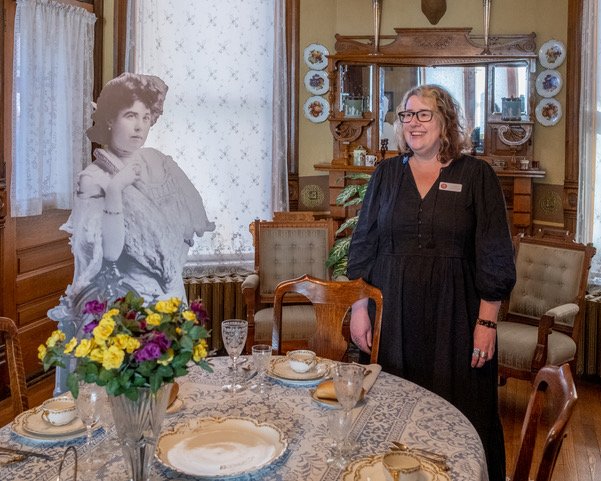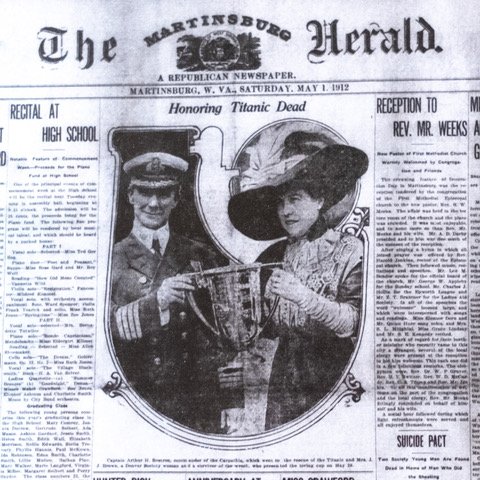A Deeper Look
Molly Brown House exhibit sheds new light on sinking of Titanic—and a famous survivor
Special to Colorado Community Media - This story was originally published in Washington Park Profile/Life on Capitol Hill, a publication of Colorado Community Media.
Andrea Malcomb, director of the Molly Brown House Museum, exchanges glances with a cardboard cut- out of Margaret Tobin Brown at the Brown family dinner table. The bowls at each setting suggest that the family’s first course might have been consommé, a clear broth often served around the turn-of-the-century. PHOTO BY TIM COLLINS
Shortly before she boarded the RMS Titanic in the spring of 1912, wealthy socialite and activist Margaret Tobin Brown played tourist in Egypt. The 45-year-old Denverite explored the pyramids by camel and shopped in a Cairo bazaar, where she bought a 3-inch high, turquoise-colored statue called an ushabti. Purportedly, such ancient tomb ornaments brought good luck. She would need it.
On the night of April 14, Brown was reading in bed in her Titanic stateroom when she felt a jolt over- head. The world’s largest luxury ocean liner had just collided with a towering iceberg. The ship sank in less than three hours, killing 1,500 passengers and crew. Brown was among the 706 who survived.
Today, that ushabti is one of many fascinating items on display in a new exhibition, “Heroine of the Titanic,” at the Molly Brown House Museum in Denver’s Capitol Hill neighborhood.
Perhaps the ushabti really saved Brown’s life — or perhaps it was her own level-headed behavior during that terrifying night. Brown was far more remarkable than most people know. She spoke five languages, studied acting in Paris under Sarah Bernhardt, crusaded for women’s voting rights, ran for Senate and won the French Legion of Honor for her relief work during World War I.
Clearly, Brown, who lived from 1867 to 1932, was a fascinating person in her own right. To prove the point, the museum is voyaging back in time to that fateful April of 1912 — in a quest to reveal not only fresh insights about the sinking, but also about a woman who may rank as Denver’s most famous but least understood.
Movie props, items salvaged from the wreck and a virtual time machine
On April 10, 1912, the newly completed RMS Titanic set sail from Southampton, England. Before setting its course for New York, the luxury liner crossed the British Channel to pick up more passengers in Cherbourg, France — including Margaret Tobin Brown. Brown’s experiences during the calamitous sinking that followed are the subject of a new exhibition at the Molly Brown House Museum in Denver. COURTESY OF HISTORIC DENVER’S MOLLY BROWN HOUSE MUSEUM
The Molly Brown House Museum show, which runs from April 1 to Sept. 25, is displaying Titanic-related items from its own collection — such as an anxious telegram Brown received from her son when she was aboard the rescue ship, Carpathia. Thirty items loaned by the Branson Titanic Museum in Missouri include artifacts salvaged from the wreck, discovered in 1985. Also on display are props from the 1997 film, “Titanic,” and the entertaining but highly inaccurate 1964 movie musical, “The Unsinkable Molly Brown.”
But Andrea Malcomb, the museum’s director, is even more excited about another artifact. In early 2020, just before the pandemic hit, the museum acquired a century-old scrapbook from descendants of the Brown family. Created in 1914, by Brown’s teenage niece, Helen Tobin, who was living in her aunt’s household at the time, the scrapbook contains news- paper interviews, photos and never-before-seen family documents. It was donated by the Vollrath/Marenholz family.
“The scrapbook is a game-changer for us,” said Malcomb. “This comes from a period in Margaret’s life where we were missing a lot of information.”
The fragile, yellowed pages offer fresh details about not only the Titanic disaster, but also Brown’s involvement in the Women’s Suffrage Movement and her 1914 run for the U.S. Senate.
According to museum curator Stephanie McGuire, the scrapbook functioned as a virtual time-machine, allowing her to immerse herself in the world of 1912.
A widely published photograph from May 29, 1912, shows Margaret Tobin Brown, chair of the Titanic Survivors Committee, presenting a silver loving cup to Captain Arthur H. Rostron of the rescue ship, Carpathia. The grateful Brown also gave Rostron her Egyptian ushabti, a good-luck talisman that accompanied her in Lifeboat Number Six. PHOTO BY TIM COLLINS
“Putting together these exhibits is a dream,” she said. “We’ve built this whole exhibit off primary sources, rather than relying on books about it.”
Added Malcomb, “There are so many myths sur- rounding Margaret. This 110th anniversary of the sinking enables us to strip away myth and show the truth.”
Harmful caricatures of Brown and other Western women
And of myths, there are many.
To set the record straight, Margaret Brown was never called “Molly,” except by Hollywood scriptwriters. As a baby, she did not float down a rushing river in her cradle. She never worked in a saloon or accidentally burned up all her husband’s hard-earned cash by hiding it in a wood stove. She did not use ex- pressions like “Gol’ durn.”
Dr. Kristen Iversen, author of the highly-regarded biography, “Molly Brown: Unraveling the Myth,” is dismayed by these fallacies. Caricaturing Western women like Molly Brown and Baby Doe Tabor is dangerous, she warned, “because the reality of these women is erased.”
As a grad student at the University of Denver, Iversen was astounded to discover a treasure trove of old clippings and other documents that put the lie to the popular conception of Brown as an ignorant saloon girl.
“She was really smart and really motivated and absolutely undaunted by the things the culture said were inappropriate for women to do,” Iversen said.
The maritime tragedy that never should have happened
Molly Brown: Myth Vs. Fact
These five fallacies and many others are busted by Kristen Iversen’s biography, “Molly Brown: Unraveling the Myth.” Perhaps the most widespread myth is the name, Molly Brown. The creative team that turned Margaret Tobin Brown’s heavily-fictionalized life story into a Broadway musical chose the nickname, Molly, because it was easier to sing. But during her lifetime, no one ever addressed Margaret Tobin Brown as Molly.
MYTH: Molly Brown worked as a saloon girl in Leadville before marrying J.J. Brown.
FACT: Margaret Tobin moved to Leadville in 1886 at age 18 to keep house for her brother, Daniel, who was hard at work in the mines. Money was tight so Margaret Tobin got a job at a local department store, where she sewed carpets, draperies and shades.
MYTH: Molly Brown was an ignorant yokel who couldn’t read or write.
FACT: Margaret Tobin grew up in a hard-working family of Irish immigrants in Hannibal, Missouri. She went to school until age 13, when she was expected to get a job to help support the household. As a young bride in Leadville and later in Denver, Margaret Tobin Brown hired tutors to further educate herself and her children. She ended up speaking five languages.
MYTH: Molly Brown was a gold digger.
FACT: After meeting the modestly paid mining engineer J.J. Brown at a Catholic church picnic in 1886, Margaret Tobin wrote, “I wanted a rich man but I loved Jim Brown.” They married the same year.
MYTH: The Browns struck gold on their claim and became wealthy overnight.
FACT: In 1893, J.J. Brown’s employer, the Ibex mining company, struck a rich vein of gold in the Little Jonny mine. By then, J.J. and Margaret Brown had been married for seven years and had two children.
MYTH: Denver’s elite Sacred Thirty-Six, controlled by socialite Louise Crawford Hill, shunned Molly Brown and her husband, J.J., as ignorant upstarts.
FACT: After moving from Leadville to Denver in 1893, J.J. and Margaret Brown quickly became respected members of Denver society and at times, attended some of the same events as the Crawford-Hills. However, Margaret Brown’s progressive political views differed drastically from the Hills, who were publishers of the conservative newspaper, “The Denver Republican.
What of the tragedy that made Brown famous? Her compassionate treatment of other passengers, many of them impoverished immigrants, won her the title, “Heroine of the Titanic.” Newspapers rushed to interview her and world renown soon followed.
According to Iversen, Brown was an excellent writer and also published her own accounts of the ordeal. She especially wanted to expose human errors that led to the tragedy.
Brown strongly criticized the ship’s excessive speed and lack of safety drills. In Iversen’s biography, Brown commented, “the Titanic disaster was a tragedy as unnecessary as running the Brown Palace into Pike’s Peak.”
Although Brown didn’t have access to current scientific research, in a larger sense, she was probably right.
The tragic sinking of the Titanic has special relevance today, in light of tragedies like the 2018 and 2019 crashes of Boeing planes in Indonesia and Ethiopia. Just as Boeing’s new management took dangerous shortcuts in their race to beat the European-made Airbus to market, evidence from the wreck of the Titanic suggests that competition between two British shipping lines — White Star, which built the Titanic and archrival Cunard — may have played a role in the sinking.
The National Institute of Standards and Technology (NIST) surmised as much, after analyzing 40 iron rivets salvaged from the wreck. According to the NIST website, the Titanic’s hull was secured with 3 million rivets made from lower grade iron with a high percentage of slag. At the time, there was a worldwide shortage of quality iron and the shipwrights — under pressure to get the boat into the water — probably settled for what was available. But the slag-filled rivets grew brittle from exposure to the icy North Atlantic. On impact with the iceberg, the rivets popped their tops, opening five of the ship’s “water tight” compartments. The ship quickly sank. The speed of the sinking was long attributed to a 300-foot gash in the hull ripped by the iceberg. Exploration of the wreck proved that this never happened.
Like many Titanic survivors, Brown was haunted by the experience for the rest of her life. But she still managed to cram in a staggering number of experiences by the time she died at age 65 — 20 years after the Titanic sank. When she wasn’t working with Denver Judge Ben Lindsey to reform harsh juvenile laws or standing up for the rights of miners in Ludlow, she was in Switzerland, learning how to yodel.
It all feels a bit daunting. How did she have time? One thing is certain: Margaret Tobin Brown never had time to be dull.


